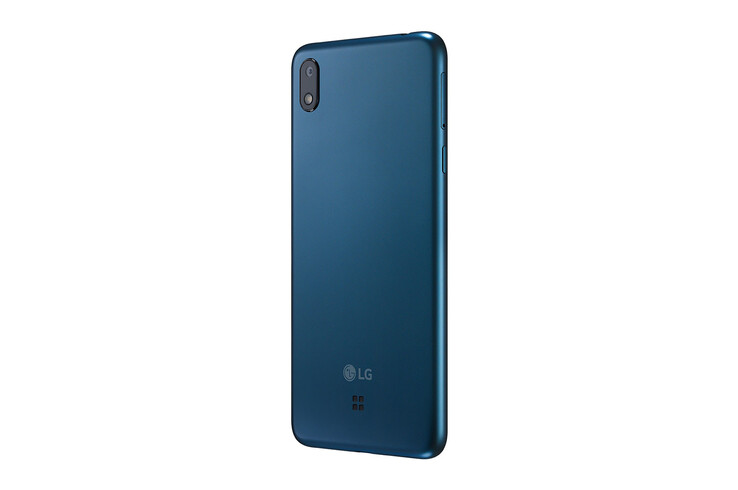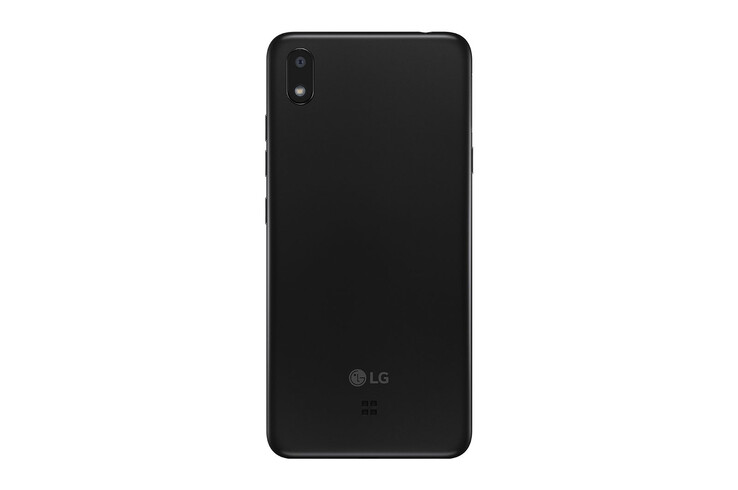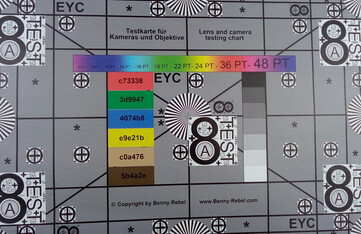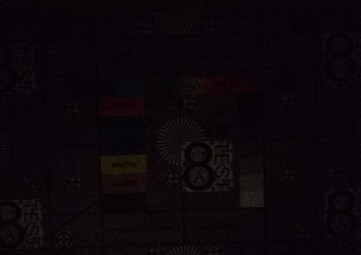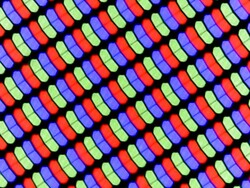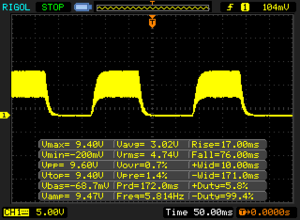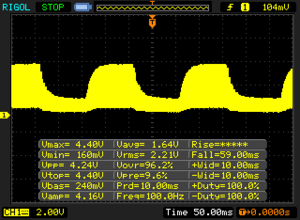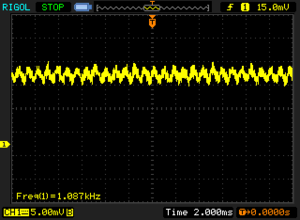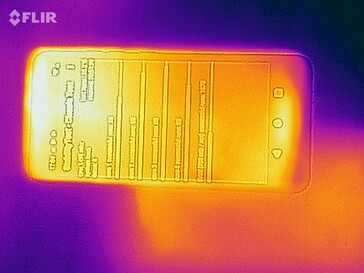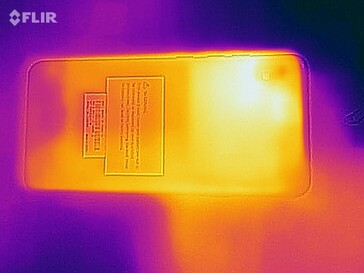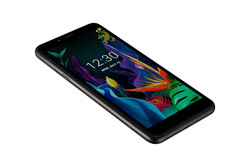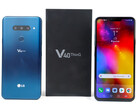LG K20 Smartphone Review – Mobile phone under 100 Euro
Comparison Units
Bewertung | Rating Version | Datum | Modell | Gewicht | Laufwerk | Groesse | Aufloesung | Preis ab |
|---|---|---|---|---|---|---|---|---|
| 68.3 % v7 (old) | v7 (old) | 12 / 2019 | LG K20 MT6739, PowerVR GE8100 | 153 g | 16 GB eMMC Flash | 5.45" | 960x480 | |
| 82.6 % v6 (old) | v6 (old) | 08 / 2019 | Xiaomi Redmi 7A SD 439, Adreno 505 | 165 g | 16 GB eMMC Flash | 5.45" | 1440x720 | |
| 73.1 % v6 (old) | v6 (old) | 02 / 2019 | Motorola Moto E5 Play 425, Adreno 308 | 150 g | 16 GB eMMC Flash | 5.20" | 960x480 | |
| 74.9 % v6 (old) | v6 (old) | 12 / 2018 | Nokia 2.1 425, Adreno 308 | 174 g | 8 GB eMMC Flash | 5.50" | 1280x720 |
Case, Equipment and Operation
With the LG K20, the manufacturer sells a very cheap smartphone for just under 100 euros. Of course, there's only a plastic chassis for it, but LG uses a blue or black, matt shimmering raw material that's easy to handle. The device looks compact and stable, although it creaks slightly under pressure when you press the back, this doesn't show up on the screen. The device is also very torsion-resistant and quite light with 153 grams.
1 GB RAM isn't much, but not unusual in this price range, only the Xiaomi Redmi 7A offers more at this price. The 16 GB mass memory also corresponds to the class average, whereby the Nokia 2.1 comes to the customer with only 8 GB. A dedicated microSD slot can be used in addition to the two SIM slots, thus the memory can be expanded by up to 32 GB, whereby our reference card Toshiba Exceria Pro M501 with 64 GB is also recognized without difficulty. The WLAN module is a bit slower than many competitors, but the differences are very small and the LG K20 offers a quite stable signal overall.
With such inexpensive smartphones, you'll almost always have to live with delays in operation, for example when you call up the list of all apps on the LG K20, otherwise operation in the menus is relatively fluid. The touchscreen has a slight delay, but you can work with it well in everyday life.
| Networking | |
| iperf3 transmit AX12 | |
| Motorola Moto E5 Play | |
| Xiaomi Redmi 7A | |
| Nokia 2.1 | |
| LG K20 | |
| iperf3 receive AX12 | |
| Xiaomi Redmi 7A | |
| Motorola Moto E5 Play | |
| LG K20 | |
| Nokia 2.1 | |
Cameras - Low resolution and blurred
8 megapixels on the back and 5 megapixels on the front? This is reminiscent of its bigger brother, the LG K30. In fact, both smartphones take pretty similar pictures: Often noisy in detail, quite cool colors and little brightened. The sharpness suffers in low light. You can use the camera for snapshots, but if you want to enlarge and print your pictures, you should look elsewhere.
Videos can be recorded in 720p and 30 fps, whereby this is an artificial restriction of the LG software, with other camera apps Full HD videos can also be recorded. The autofocus here is a bit slow and brightness transitions are clearly visible. Overall, the video quality is OK for the price range.
The front camera has a hard time hitting the right sharpness.
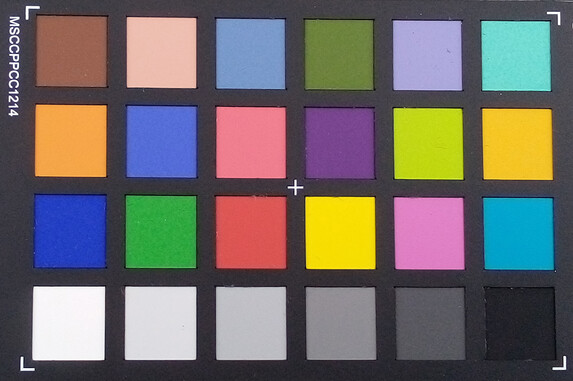
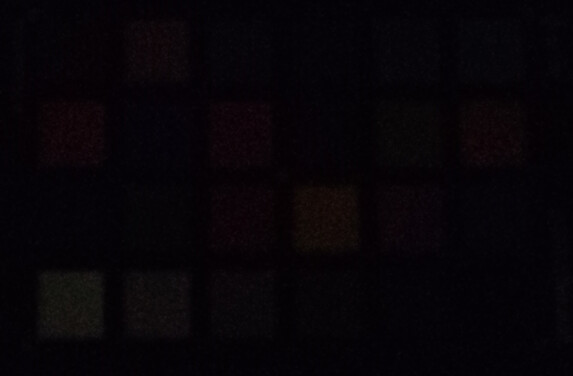
Display - Low resolution
With 960 x 480 pixels, the resolution of the display in the LG K20 is quite low, just 197 pixels per inch is a low value. In terms of brightness, the LG K20 is at class level, but the Xiaomi Redmi 7A shows that it's also much brighter. We're not very enthusiastic about the color reproduction that we determine in our tests with the CalMAN software: The deviations are quite high, there is a violent blue cast and colors look very dull on the screen.
The reaction times are also very long, so that there can be visible delays when the image changes quickly.
| |||||||||||||||||||||||||
Brightness Distribution: 86 %
Center on Battery: 362 cd/m²
Contrast: 1034:1 (Black: 0.35 cd/m²)
ΔE ColorChecker Calman: 8.4 | ∀{0.5-29.43 Ø4.78}
ΔE Greyscale Calman: 9.7 | ∀{0.09-98 Ø5}
90.6% sRGB (Calman 2D)
Gamma: 2.605
CCT: 9313 K
| LG K20 IPS, 960x480, 5.5" | Xiaomi Redmi 7A IPS, 1440x720, 5.5" | Motorola Moto E5 Play IPS, 960x480, 5.2" | Nokia 2.1 IPS, 1280x720, 5.5" | |
|---|---|---|---|---|
| Response Times | 61% | 47% | 49% | |
| Response Time Grey 50% / Grey 80% * (ms) | 59 ? | 32 ? 46% | 50 ? 15% | 42 ? 29% |
| Response Time Black / White * (ms) | 93 ? | 22 ? 76% | 20 ? 78% | 30 ? 68% |
| PWM Frequency (Hz) | 1087 ? | 384.6 ? | 1961 ? | 2273 |
| Screen | 11% | -11% | 17% | |
| Brightness middle (cd/m²) | 362 | 533 47% | 369 2% | 338 -7% |
| Brightness (cd/m²) | 347 | 506 46% | 358 3% | 327 -6% |
| Brightness Distribution (%) | 86 | 88 2% | 81 -6% | 82 -5% |
| Black Level * (cd/m²) | 0.35 | 0.6 -71% | 0.4 -14% | 0.27 23% |
| Contrast (:1) | 1034 | 888 -14% | 923 -11% | 1252 21% |
| Colorchecker dE 2000 * | 8.4 | 5.6 33% | 9.75 -16% | 5.36 36% |
| Colorchecker dE 2000 max. * | 15 | 11.4 24% | 18.28 -22% | 9.77 35% |
| Greyscale dE 2000 * | 9.7 | 7.4 24% | 11.8 -22% | 6.2 36% |
| Gamma | 2.605 84% | 2.212 99% | 2.057 107% | 2.345 94% |
| CCT | 9313 70% | 7974 82% | 11971 54% | 8460 77% |
| Color Space (Percent of sRGB) (%) | 78.6 | |||
| Total Average (Program / Settings) | 36% /
21% | 18% /
1% | 33% /
23% |
* ... smaller is better
Display Response Times
| ↔ Response Time Black to White | ||
|---|---|---|
| 93 ms ... rise ↗ and fall ↘ combined | ↗ 17 ms rise | |
| ↘ 76 ms fall | ||
| The screen shows slow response rates in our tests and will be unsatisfactory for gamers. In comparison, all tested devices range from 0.1 (minimum) to 240 (maximum) ms. » 100 % of all devices are better. This means that the measured response time is worse than the average of all tested devices (20.2 ms). | ||
| ↔ Response Time 50% Grey to 80% Grey | ||
| 59 ms ... rise ↗ and fall ↘ combined | ↗ 0 ms rise | |
| ↘ 59 ms fall | ||
| The screen shows slow response rates in our tests and will be unsatisfactory for gamers. In comparison, all tested devices range from 0.165 (minimum) to 636 (maximum) ms. » 95 % of all devices are better. This means that the measured response time is worse than the average of all tested devices (31.6 ms). | ||
Screen Flickering / PWM (Pulse-Width Modulation)
| Screen flickering / PWM detected | 1087 Hz | ≤ 10 % brightness setting | |
The display backlight flickers at 1087 Hz (worst case, e.g., utilizing PWM) Flickering detected at a brightness setting of 10 % and below. There should be no flickering or PWM above this brightness setting. The frequency of 1087 Hz is quite high, so most users sensitive to PWM should not notice any flickering. In comparison: 53 % of all tested devices do not use PWM to dim the display. If PWM was detected, an average of 8098 (minimum: 5 - maximum: 343500) Hz was measured. | |||
Performance, Emissions and Battery life
The Mediatek MT6739 is a bit older, and a bit slower overall than the Snapdragon 425, which is used in many price range devices. There are noticeable delays every now and then, but overall you can navigate through the menus more or less smoothly. microSD cards are read quite quickly, but the internal memory is very slow. This is shown by delayed app starts and long data transfer times. There is hardly any noticeable warming under a longer load.
The speaker is located at the back of the smartphone, it barely radiates deep mid-range frequencies, but still has quite balanced highs. Nevertheless, some of the frequencies are quite unpleasant in the ears, vocals and speech seem quite thin. Overall, the speaker is only suitable as an emergency solution. The device can be connected to audio devices via a 3.5mm socket and Bluetooth, which didn't cause any problems.
With 3000 mAh, the LG K20 lags somewhat behind its competitors when it comes to battery performance. The battery life of 11:14 hours is still usable in our WLAN test, but for example 20% shorter than with the Nokia 2.1. The smartphone is sufficient for one working day, but charging takes quite a long time with over two hours.
| PCMark for Android | |
| Work performance score (sort by value) | |
| LG K20 | |
| Xiaomi Redmi 7A | |
| Motorola Moto E5 Play | |
| Nokia 2.1 | |
| Average Mediatek MT6739 (3742 - 5136, n=11) | |
| Work 2.0 performance score (sort by value) | |
| LG K20 | |
| Xiaomi Redmi 7A | |
| Motorola Moto E5 Play | |
| Nokia 2.1 | |
| Average Mediatek MT6739 (2467 - 5377, n=16) | |
| GFXBench (DX / GLBenchmark) 2.7 | |
| 1920x1080 T-Rex Offscreen (sort by value) | |
| LG K20 | |
| Xiaomi Redmi 7A | |
| Motorola Moto E5 Play | |
| Nokia 2.1 | |
| Average Mediatek MT6739 (4.9 - 6.1, n=17) | |
| Average of class Smartphone (22 - 954, n=155, last 2 years) | |
| T-Rex Onscreen (sort by value) | |
| LG K20 | |
| Xiaomi Redmi 7A | |
| Motorola Moto E5 Play | |
| Nokia 2.1 | |
| Average Mediatek MT6739 (8.2 - 15, n=17) | |
| Average of class Smartphone (12 - 166, n=155, last 2 years) | |
| LG K20 | Xiaomi Redmi 7A | Motorola Moto E5 Play | Nokia 2.1 | Average 16 GB eMMC Flash | Average of class Smartphone | |
|---|---|---|---|---|---|---|
| AndroBench 3-5 | 107% | 164% | 117% | 28% | 3170% | |
| Sequential Read 256KB (MB/s) | 41.9 | 258 516% | 279 566% | 288.3 588% | 164.5 ? 293% | 2228 ? 5217% |
| Sequential Write 256KB (MB/s) | 71.8 | 68.7 -4% | 52.2 -27% | 51.2 -29% | 43 ? -40% | 1852 ? 2479% |
| Random Read 4KB (MB/s) | 29.7 | 57.8 95% | 46.31 56% | 50.5 70% | 21.7 ? -27% | 296 ? 897% |
| Random Write 4KB (MB/s) | 8.1 | 9.6 19% | 43.16 433% | 13.45 66% | 8.08 ? 0% | 339 ? 4085% |
| Sequential Read 256KB SDCard (MB/s) | 78.4 ? | 85.2 ? 9% | 83.7 ? 7% | 79.4 ? 1% | 59.1 ? -25% | |
| Sequential Write 256KB SDCard (MB/s) | 60.3 ? | 64.6 ? 7% | 28.83 ? -52% | 61.9 ? 3% | 39.8 ? -34% |
Temperature
(+) The maximum temperature on the upper side is 37.2 °C / 99 F, compared to the average of 35.2 °C / 95 F, ranging from 21.9 to 247 °C for the class Smartphone.
(+) The bottom heats up to a maximum of 37.9 °C / 100 F, compared to the average of 34 °C / 93 F
(+) In idle usage, the average temperature for the upper side is 29.6 °C / 85 F, compared to the device average of 32.9 °C / 91 F.
Loudspeakers
LG K20 audio analysis
(+) | speakers can play relatively loud (82 dB)
Bass 100 - 315 Hz
(-) | nearly no bass - on average 64.6% lower than median
(+) | bass is linear (0% delta to prev. frequency)
Mids 400 - 2000 Hz
(-) | nearly no mids - on average 64.6% lower than median
(+) | mids are linear (0% delta to prev. frequency)
Highs 2 - 16 kHz
(-) | nearly no highs - on average 64.6% lower than median
(+) | highs are linear (0% delta to prev. frequency)
Overall 100 - 16.000 Hz
(-) | overall sound is not linear (120.7% difference to median)
Compared to same class
» 89% of all tested devices in this class were better, 9% similar, 2% worse
» The best had a delta of 11%, average was 35%, worst was 134%
Compared to all devices tested
» 97% of all tested devices were better, 3% similar, 1% worse
» The best had a delta of 4%, average was 24%, worst was 134%
Xiaomi Redmi 7A audio analysis
(+) | speakers can play relatively loud (82 dB)
Bass 100 - 315 Hz
(-) | nearly no bass - on average 67.5% lower than median
(+) | bass is linear (0% delta to prev. frequency)
Mids 400 - 2000 Hz
(-) | nearly no mids - on average 67.5% lower than median
(+) | mids are linear (0% delta to prev. frequency)
Highs 2 - 16 kHz
(-) | nearly no highs - on average 67.5% lower than median
(+) | highs are linear (0% delta to prev. frequency)
Overall 100 - 16.000 Hz
(-) | overall sound is not linear (126.1% difference to median)
Compared to same class
» 96% of all tested devices in this class were better, 3% similar, 1% worse
» The best had a delta of 11%, average was 35%, worst was 134%
Compared to all devices tested
» 99% of all tested devices were better, 1% similar, 0% worse
» The best had a delta of 4%, average was 24%, worst was 134%
Battery Life
| LG K20 3000 mAh | Xiaomi Redmi 7A 4000 mAh | Motorola Moto E5 Play 2120 mAh | Nokia 2.1 4000 mAh | Average of class Smartphone | |
|---|---|---|---|---|---|
| Battery Runtime | |||||
| WiFi Websurfing (h) | 11.2 | 14.2 27% | 6.4 -43% | 13.5 21% | 19.3 ? 72% |
Pros
Cons
Verdict - Is the LG K20 worth considering?
"What can you expect for less than 100 euros?" So one could say, if one looks at the LG K20: It's a compact smartphone with very low specifications, sufficient for the simplest tasks, but never really fun. But on the other hand, there are also competing devices that offer more for similarly little money: More battery, more power, more screen resolution.
Positive aspects of the LG K20 are the low heat build-up under load, the dedicated microSD slot, a decent chassis and a stable WLAN signal. The moderate speaker, the low-resolution screen with a strong blue cast, the partly blurred camera images and the screen's long response times are on the negative side.
The LG K20 is a cheap smartphone that doesn't offer much that's extraordinary.
The LG K20 would have to be a bit cheaper again to overlook the weak points. So it remains a pretty average cheap smartphone.
LG K20
- 12/01/2019 v7 (old)
Florian Schmitt




